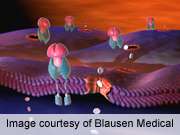Exercise impacts adipose tissue via eNOS mechanisms

(HealthDay)—There is a crucial role played by endothelial nitric oxide synthase (eNOS)-derived nitric oxide (NO) in the metabolic adaptation of subcutaneous adipose tissue to exercise training, according to an animal study published online May 13 in Diabetes.
Elisabetta Trevellin, Ph.D., of the University of Padua in Italy, and colleagues studied the in vivo effects of chronic exercise in subcutaneous adipose tissue of wild type (WT) and endothelial nitric oxide synthase (eNOS) knockout (eNOS-/-) mice following a period of swim training. The researchers also examined the in vitro effects of nitric oxide (NO) on mouse 3T3-L1 and human subcutaneous adipose tissue-derived adipocytes following a chronic treatment with a NO donor (DETA-NO).
The researchers found that, following swim training, mitochondrial biogenesis, mitochondrial DNA content, and glucose uptake were increased in the subcutaneous adipose tissue of WT, but not eNOS-/-, mice. DETA-NO promoted mitochondrial biogenesis and elongation, glucose uptake, and GLUT4 translocation in cultured murine and human adipocytes.
"These results point to the crucial role of the eNOS-derived NO in the metabolic adaptation of subcutaneous adipose tissue to exercise training," the authors write.
More information:
Abstract
Full Text (subscription or payment may be required)
Copyright © 2014 HealthDay. All rights reserved.


















